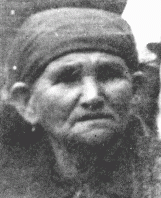You searched for: V%20%E5%B7%B4%E5%93%88%E9%A6%AC%E6%B8%B8%E6%88%B2%7BWWW%2CRT33%2CTOP%7D%E4%BB%A3%E7%A2%BCb77%7D%E9%A2%B1%E9%A2%A8%E9%81%8A%E6%88%B2%F0%9F%90%BE%E7%9C%9F%E4%BA%BA%E7%99%BE%E5%AE%B6%E6%A8%82%F0%9F%98%B8%E4%B8%BB%E8%A6%81%E9%81%8A%E6%A8%82%E5%A0%B4%E5%90%8D%E5%96%AE%E2%83%94%E8%B6%B3%E7%90%83%E9%8C%A6%E6%A8%99%E8%B3%BD%E8%B3%A0%E7%8E%87%E0%AE%92%E5%9C%A8%E5%93%AA%E8%A3%A1%E7%9C%8B%E8%8B%B1%E8%B6%85%E8%81%AF%E8%B3%BD%E0%A4%9C%E7%B6%AD%E5%A0%A1%E5%A4%AB%E1%87%B1%E6%89%80%E7%BE%85%E9%96%80%E7%BE%A4%E5%B3%B6%E9%81%8A%E6%88%B2%E2%85%A4%E4%B8%80%E6%AC%A1%20X%20%E6%8A%95%E6%B3%A8%E6%8F%90%E6%AC%BE%E2%89%B8.xhc/
<< Previous | Displaying results 126-150 of 519 for "V%20%E5%B7%B4%E5%93%88%E9%A6%AC%E6%B8%B8%E6%88%B2%7BWWW%2CRT33%2CTOP%7D%E4%BB%A3%E7%A2%BCb77%7D%E9%A2%B1%E9%A2%A8%E9%81%8A%E6%88%B2%F0%9F%90%BE%E7%9C%9F%E4%BA%BA%E7%99%BE%E5%AE%B6%E6%A8%82%F0%9F%98%B8%E4%B8%BB%E8%A6%81%E9%81%8A%E6%A8%82%E5%A0%B4%E5%90%8D%E5%96%AE%E2%83%94%E8%B6%B3%E7%90%83%E9%8C%A6%E6%A8%99%E8%B3%BD%E8%B3%A0%E7%8E%87%E0%AE%92%E5%9C%A8%E5%93%AA%E8%A3%A1%E7%9C%8B%E8%8B%B1%E8%B6%85%E8%81%AF%E8%B3%BD%E0%A4%9C%E7%B6%AD%E5%A0%A1%E5%A4%AB%E1%87%B1%E6%89%80%E7%BE%85%E9%96%80%E7%BE%A4%E5%B3%B6%E9%81%8A%E6%88%B2%E2%85%A4%E4%B8%80%E6%AC%A1%20X%20%E6%8A%95%E6%B3%A8%E6%8F%90%E6%AC%BE%E2%89%B8.xhc/" | Next >>
-
Lea Ofner-Szemere
ID CardLea was born in the city of Sombor in northeastern Yugoslavia. When she was 3 years old, her parents divorced and she moved to Vienna with her mother, who taught English and French to Austrian children. Lea enjoyed living in Vienna as a child. 1933-39: Lea returned to Sombor almost every year to visit her mother's relatives. There, she became reacquainted with her younger half-sister, Julia, and her older half-brother, Francis, and would miss them when she returned to Vienna. In 1938, the Germans annexed…

-
The German Military and the Holocaust
ArticleThe German military played a vital role in the consolidation of Nazi power and persecution and mass murder of Jews and other groups. Learn more
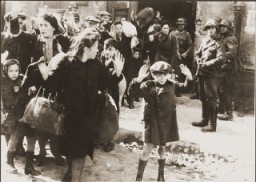
-
Israel Yitzak Kisielnicki
ID CardThe youngest of three children, Israel Yitzak was born to Jewish parents living 35 miles east of Warsaw in the small, predominantly Jewish town of Kaluszyn. Israel's mother was a housewife, and his father was a merchant who often traveled on business, by horse and wagon, to Warsaw. Israel attended public school and also received religious instruction. 1933-39: When Germany invaded Poland several days ago, many kids Israel's age, afraid of what would happen if the Germans occupied Poland, fled to the USSR,…

-
William Denson describes the nature of the evidence uncovered for postwar trials of concentration camp personnel
Oral HistoryWilliam Denson graduated from the US Military Academy at West Point in 1934 and attended Harvard Law School. He returned to West Point to teach law from 1942 until 1945. In January 1945, Denson accepted the position of Judge Advocate General (JAG) in Europe and was assigned to US Third Army headquarters in Germany. He took part in more than 90 trials against Germans who had committed atrocities against downed American pilots. In August 1945, Denson became chief prosecutor for the US government at the…

-
The Aftermath of the Holocaust
Animated MapView an animated map describing some of the challenges survivors faced in the aftermath of the Holocaust, when many feared returning to their former homes.

-
Hermann Ludwig Maas
ArticleHermann Ludwig Maas, a Protestant pastor in Heidelberg, Germany, was a rescuer and clergyman who stood in solidarity with the Jewish community.
-
Dr. Robert Ritter visits a "Gypsy camp"
PhotoDr. Robert Ritter talks to several residents in a Zigeunerlager ("Gypsy camp"). Hamburg, Germany, 1940. During the Nazi era, Dr. Robert Ritter was a leading authority on the racial classification of people pejoratively labeled “Zigeuner” (“Gypsies”). Ritter’s research was in a field called eugenics, or what the Nazis called “racial hygiene.” Ritter worked with a small team of racial hygienists. Among them were Eva Justin and Sophie Ehrhardt. Most of the people whom Ritter studied and…

-
Eva Justin interviews a Romani woman interned in a "Gypsy camp"
PhotoA color photograph of Eva Justin interviewing a Romani woman interned in a "Gypsy camp." Vienna, Austria, 1940. During the Nazi era, Dr. Robert Ritter was a leading authority on the racial classification of people pejoratively labeled “Zigeuner” (“Gypsies”). Ritter’s research was in a field called eugenics, or what the Nazis called “racial hygiene.” Ritter worked with a small team of racial hygienists. Among them were Eva Justin and Sophie Ehrhardt. Most of the people whom Ritter studied and…

-
A family interned in a "Gypsy camp"
PhotoA family stands outside of their wagon while interned in a Zigeunerlager ("Gypsy camp"). In the background, children are crowded around Eva Justin. Justin worked for the Center for Research on Racial Hygiene and Demographic Biology. Schleswig-Holstein, Germany, 1938. During the Nazi era, Dr. Robert Ritter was a leading authority on the racial classification of people pejoratively labeled “Zigeuner” (“Gypsies”). Ritter’s research was in a field called eugenics, or what the Nazis called…

-
Soviet prisoners of war wait for rations
PhotoSoviet prisoners of war wait for food in Stalag (prison camp) 8C. More than 3 million Soviet soldiers died in German custody, mostly from malnutrition and exposure. Zagan, Poland, February 1942. Second only to the Jews, Soviet prisoners of war were the largest group of victims of Nazi racial policy.
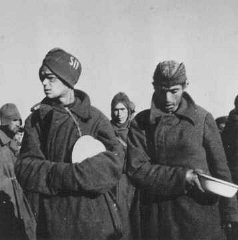
-
SS and Police
ArticleDuring World War II, SS and police leaders played a key role in the mass murder of Europe’s Jews. Learn how Himmler combined the SS and police to create a radical weapon for the Nazi regime.

-
Hodonín U Kunštátu (Hodonín bei Kunstadt) (Roma camp)
ArticleIn March 1942, the Hodonin camp was classified as a camp for Roma. It was a transfer station during deportation to Auschwitz-Birkenau. Learn about the camp and its history.

-
The Immigration of Refugee Children to the United States
ArticleMore than one thousand unaccompanied refugee children fleeing Nazi persecution arrived in the United States between 1933 and 1945. Learn more

-
UN Convention on the Prevention and Punishment of Genocide
Timeline EventJanuary 12, 1951. On this date, the United Nations Convention on the Prevention and Punishment of Genocide entered into force.
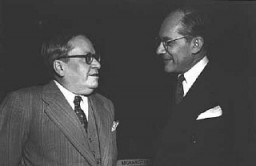
-
1940: Key Dates
ArticleExplore a timeline of key events during 1940 in the history of Nazi Germany, World War II, and the Holocaust.

-
Insignia of the 101st Airborne Division
PhotoInsignia of the 101st Airborne Division. The nickname of the 101st Airborne Division, "Screaming Eagles," originates from the division's insignia, a bald eagle on a black shield. "Old Abe" was the eagle mascot of a Wisconsin regiment during the Civil War. The 101st was formed as a reserve unit in Wisconsin shortly after World War I and included "Old Abe" as part of the division's insignia.

-
Life After the Holocaust: Thomas Buergenthal
ArticleAfter WWII and the fall of the Nazi regime, Holocaust survivors faced the daunting task of rebuilding their lives. Listen to Thomas Buergenthal's story.

-
Jeno Muhlrad
ID CardJeno was the youngest of five children born to Jewish parents living in a suburb of Budapest. His father was a wholesale merchant who sold beer to restaurants and stores. After receiving a university diploma, Jeno became a pharmacist. He and his wife, Aranka, and their two children, Eva and Andras, shared a large old house in Ujpest with Jeno's father and other members of the extended family. 1933-39: Jeno's friends and family have helped him raise the large amount of money he needs to lease his own…

-
Dora Unger
ID CardDora, her parents, brother, aunt, uncle, and two cousins lived together in her grandfather's home in Essen, Germany. The Ungers were an observant Jewish family, and when Dora was 8, she began to regularly attend meetings of Brit HaNoar, a religious youth organization. 1933-39: In October 1938 a teacher, with tears in her eyes, came to Dora at the municipal pool, saying "Jews cannot swim here anymore." Just weeks later, on November 9, Jews were arrested and their property destroyed. A neighbor tried to…

-
Jeno Nemeth
ID CardJeno moved to Szentes from a tiny farming community near the city of Szolnok, where he and his two brothers had been born to Jewish parents. Jeno owned a store that carried groceries and hardware items. He lived in the southeast Hungarian town of Szentes. Jeno and his wife, Juliana, had two married daughters, Barbara and Margit. Their son, Desider, was a dentist in Szentes. 1933-39: Jeno and his wife work hard in their store. The Depression of the 1930s was devastating, but things are starting to get a…

-
Collaboration
ArticleTo perpetrate the Holocaust, Nazi Germany relied on the help of allies and collaborators from across Europe, including governments, institutions, and individuals.

-
Hidden Children: Hardships
ArticleParents, children, and rescuers faced daunting challenges once the decision was made for a child to go into hiding during the Holocaust.

-
Klaus Barbie: The Butcher of Lyon
ArticleKlaus Barbie, chief of the Gestapo in Lyon, France, was nicknamed the "Butcher of Lyon" for his brutal actions towards Jews and members of the French Resistance.
-
The Krochmalna Street Orphanage
PhotoExterior view of the Jewish orphanage run by Janusz Korczak. Established in 1912, the orphanage was located at 92 Krochmalna Street in Warsaw, Poland. Photo taken circa 1935.
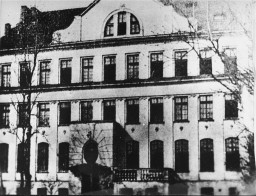
-
Terez Goldberger Kalman
ID CardTerez came from a religious Jewish family. She and her husband, Samuel, raised eight children in Satoraljaujhely, in northeastern Hungary. The Kalmans lived on the outskirts of the city, and in the 1920s they ran a canteen for the soldiers who lived in the nearby barracks. The Kalmans were proud Hungarians; one of their sons had died in World War I. 1933-39: Since Samuel died a few years ago, Terez has been alone here in her house in Satoraljaujhely. Many of her children live nearby, though, so her home…
